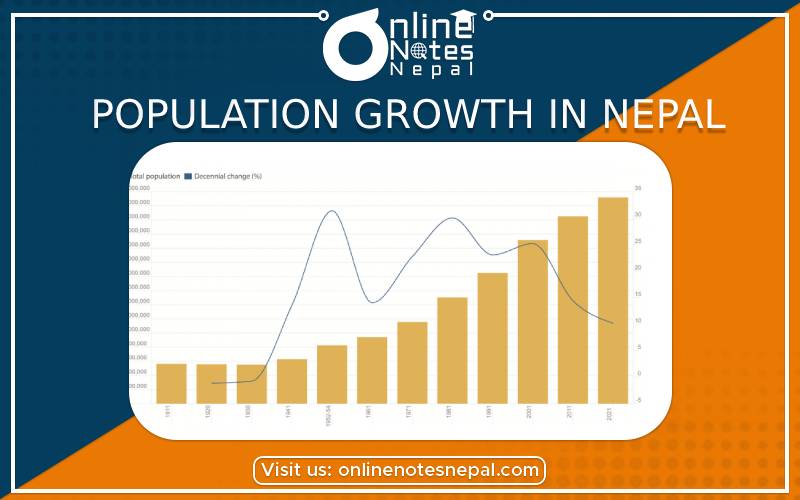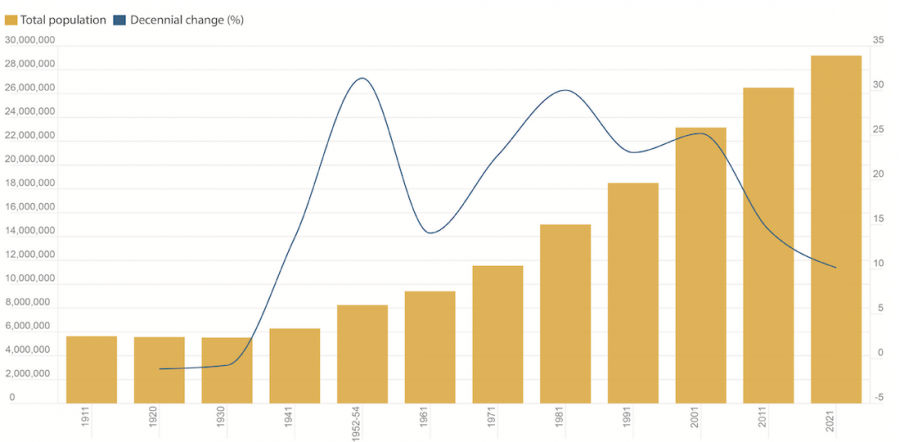Published by: Nuru
Published date: 27 Jan 2022

Population Growth in Nepal is now 0.93 and Nepal’s population is 29,192,480 according to the census of 2021.
The population is defined as the total number of people living in a particular place at a particular time. Population growth is the average annual percent change in the population, resulting from a surplus (or deficit) of births over deaths and the balance of migrants entering and leaving a country. Nepal has a high population growth rate.
The average population growth rate of 1991-2001 is 2.24 percent. The growth rate of population for the decade of 2001 to 2011 A.D was just 1.35 % per year. The pattern of growth rate is very uneven. According to the census of 2011 A.D., the population of Terai Region is 50.27%, the population of Hilly Region is 43% and the population of Mountain Region is 6.73%. The population growth trend can be studied from the following table:
| Census Year (AD) | Population | Growth rate % |
| 1911 | 5338749 | - |
| 1921 | 5573788 | -0.12 |
| 1931 | 5532574 | -0.07 |
| 1941 | 6283649 | 1.16 |
| 1951 | 8256625 | 2.28 |
| 1961 | 9412996 | 1.64 |
| 1971 | 11555983 | 2.05 |
| 1981 | 15022839 | 2.62 |
| 1991 | 18491097 | 2.08 |
| 2001 | 23151423 | 2.25 |
| 2011 | 26494504 | 1.35 |
| 2021 | 29192480 | 0.93 |

From the above table, we can say that the population of Nepal has been growing since 1931 A.D. The current census report indicates the decrease of the population growth. It is because of the increased rate of family planning devices and their use, foreign employment, population education etc. The increment and decrement of a country are determined by some factors. They are mentioned below:
Illitrate people think that children are the gift from god. So, they never stop giving birth to children. Illiterate people are economically incapable. So, uneducated parents believe that if they have more children, they can earn money. They have no idea about the family planning. People get married early due to illiteracy. Because of early marriage, females produce more children thereby increasing the population.
Religious belief is the social factor that changes the population. Conservative people do not believe in modern thoughts. They believe that the use of family planning is against the religion. They accept the birth of a child as a gift of god. It promotes population growth.
Marriage is compulsory in the Nepalese society. Early marriage is preferred by most of the parents. People get married early because of the parental pressure, ignorance and social beliefs. Ignorance is the most responsible factor for early marriage. Even child marriage is in practice. There will be the possibilities of the higher number of children in a family because of the longer span of fertile period.
Uneducated people are likely to be unaware of the importance of small family and disadvantages of bearing a large number of children. Illiterate people are indifferent to the use of family planning. Hence, there is higher fertility in an uneducated family. The educated family does have a lower birth rate.
Unemployment has played an active role in the growth of population in our country. The majority of labour power has to sit idle without work. Thus, the male and female have to pass their lives without the source of entertainment, so they are induced to indulge in sex. In such situation, there is a higher possibility of producing children.
In the Nepalese Society, a son is preferred than a daughter. Sons are regarded as wealth while daughters are a burden. They have a strong belief that managing their daughters for marriage is their sole responsibility. This kind of gender discrimination has promoted early marriage. Early marriage is risky for both men and women. The girl may start to bear a child at the early age resulting in the possibility of giving birth to more than two children.
Poor people are uneducated, unaware and not rational enough to the negative consequences of having more number of children. Children are their income source. They think that the children will help in their work to earn. So, they bear more children. They do not know the negative consequences of having more number of children. A family with a better income source and status are likely to have a small size of the family.
The population growth has been favored by social customs and traditions. Because of our social and cultural customs, people usually produce more children. People of our society believe that a family becomes stronger if it has many members. Females of the ages between 15 years and 49 years have the capacity to produce children. Because of the early marriage, females have more chances of producing more children. It increases the population.